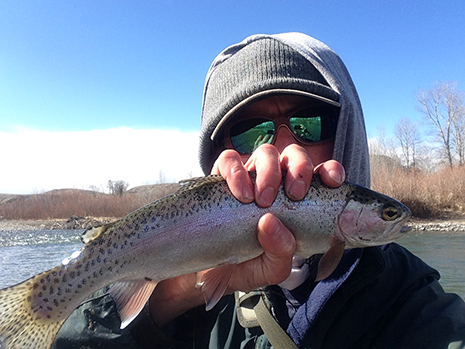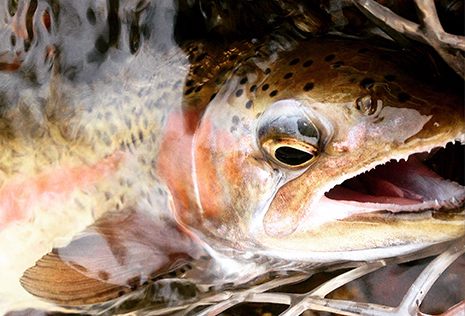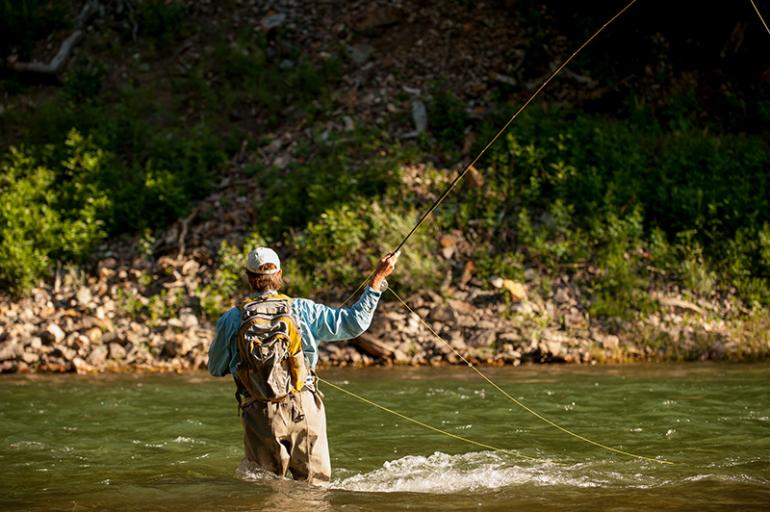Inflicted Joy
The yin and yang of fly fishing.
A few months ago, I posted a grip-and-grin selfie with a spunky little rainbow I caught near Livingston. It was the last day of a 14-day trip, an excursion that forced me to ask myself if I really enjoy fly fishing. Or has it become a life-consuming obsession filled with hours of confidence-crushing refusals, mercifully pocked with occasional bouts of elation? While that mental road is one we all must go down once in a while, my frequent paying of that toll left my spiritual tank riding near “E”, and the thought of donning waders for another cold, windy, and underwhelming day of nymphing didn't exactly have me firing out of bed in the morning.
The one day, then, that the pre-spawn rainbows were eating heartily, left me giddy and ready to prove to the world (and myself) that I do indeed know how to catch a fish, a sentiment that a day before was like the rainbow—up in the air. So there you have it, a fish suspended up in the air looking perplexedly at the camera, and yes, being forced to suck air for a few seconds while my numb fingers groped awkwardly for my phone's camera app.
A good friend later posted the comment “keep ’em wet” in reaction to my photo, to which I replied, “Does drawn butter and lemon count as ‘keeping ’em wet?’” After the initial visceral rush of snarky “you can’t tell me what to do” irrationality subsided, I had to admit that he was right — for the same reason we use soft rubber nets, barbless hooks, and lead-free split shot: because we care.

Something's wrong with this picture.
Can fish handle the air time? Sure, just as we can handle a little underwater time. Can we at times, like saying goodbye to a friend, prolong the moment for too long until both of us are uncomfortable? Undoubtedly. Does the world need another trout-gun pic? Hmmmmm.
To answer these questions, we need facts, which, by the time they “make it to the river” are often confuddled and confabulated. We talk about mortality rates, with air exposure as a main cause of death. Fishermen hasten evolution by holding fish out of water, expecting them to miraculously start breathing air. It should be safely assumed by anyone with middle-school biology under his belt that the timer starts the moment that fish begins its atmospheric adventure. Whatever the statistic, I think we all can agree that trout have better places to be than playing superman.
A few days ago, I saw a picture of a beautiful Atlantic salmon my commenting buddy caught, which to be fair, was still in the water when the picture was taken. But it got me thinking: it seems funny to care so much about the ten seconds we haul a fish out of the water for a photo, but not about the five or more minutes we spend pulling the fish around by a sharp piece of steel piercing its head. Maybe instead of saying “keep ’em wet”, we should be saying “give that poor fish an aspirin.” It’s interesting how we chose to accept one form of inflicted pain as unavoidable, but then make a big stink out of what is essentially just an effect of the cause. In the end, if we really cared about the welfare of the fish, we should probably just stay home. But that isn’t an option now, is it?
So what’s worse for the fish: a piece of facially-impaled steel, or a bit of air time? This question sent me scouring the web for answers. Like a soon-to-be-dead character in a horror movie, I descended the cellar stairs, without turning on the light, walking one creaky step at a time to my imminent doom. Like the slasher-film victim, I descended past the point of no return — past being blissfully ignorant in my conviction that while they are animate beings, fish are without the ability to feel pain as we do.
I’ll save you the Biology 101 research paper and say simply that after reading a slew of articles from various academic, scientific, and obviously end-of-the-spectrum organizations, I came to this conclusion: fish feel pain — but not like we do… we think… probably.
If you take the current research out there, barring any new late-breaking studies, the common consensus is that fish, like us, have nerve endings which transmit sensations to the brain. Studies have shown that fish react to pain stimuli, but does that mean they feel pain? Some people point to the practice of ringing a bull’s nose, which I bet is painful as all get out and is why they follow you around when pulled by the ring. If a trout was in pain, wouldn’t it just go with your pulling instead of performing half-gainers and peeling line off your reel? If you need an answer, most people agree they feel some facsimile of pain, but where we leave the fish behind is in our psychological capacity to make any pain way worse by adding psychological trauma from past pain to the present moment.
All of this research and soul-searching left me antsy, so I grabbed my waders and a rod or two and headed out for some quiet time on the water. For my part, I have always tried to treat the fish I catch with a modicum of respect and care; after all, regardless of how they got into their current predicament, they are still a living being that deserves to be treated as such. My friend’s comment also got me thinking more creatively about how I capture that moment on film. Instead of the played out grip-and-grin, I have been trying to tell a different story with my lens — say maybe by just capturing some fish and some water while the fish is still breathing liquids, or by getting a waterproof camera case and taking the picture to the fish instead of the fish to the picture.

Keepin' 'em wet, and still getting the shot.
If you really need that human-holding-a-fish pic, be quick and don’t take a selfie — that’s always tougher on the fish and the resulting shot is usually horrid. Body-mounted cameras are a cool option, as is a tripod, or a fishing buddy willing to put down his gear — or beer — to take a picture for you.
Buddha says, “Pain is inevitable, suffering is optional.” While I don’t relish the role as the inflicter of pain, I do relish the trout’s role as the inflicter of joy. Someday, I might be that guy who clips the bend off his flies and lives for the take without the need for pain, joy, and a good long fight. At that point I will no longer need to fish. Hell, maybe I’ll just want to sit on the bank and watch the afternoon subvaria hatch. For now, I need the pain from the fish. I need that reality, that truth that the world hurts and someday it’ll be our turn to get fooled by a well-dressed dry fly.













